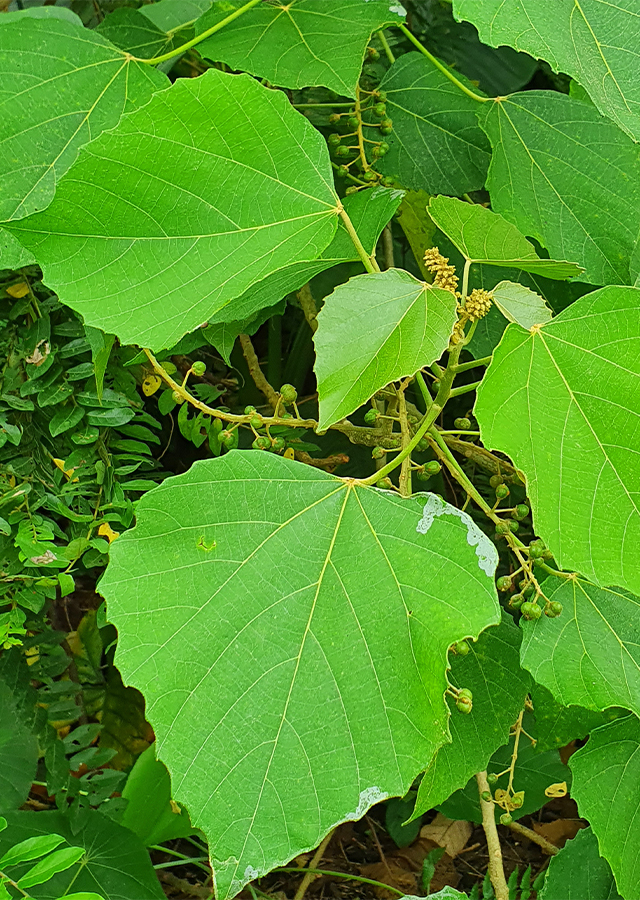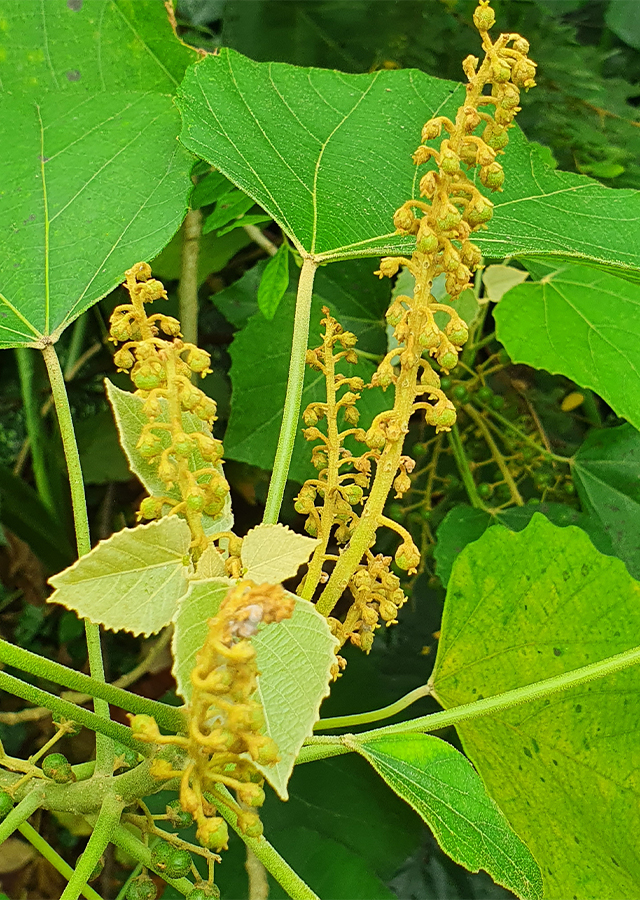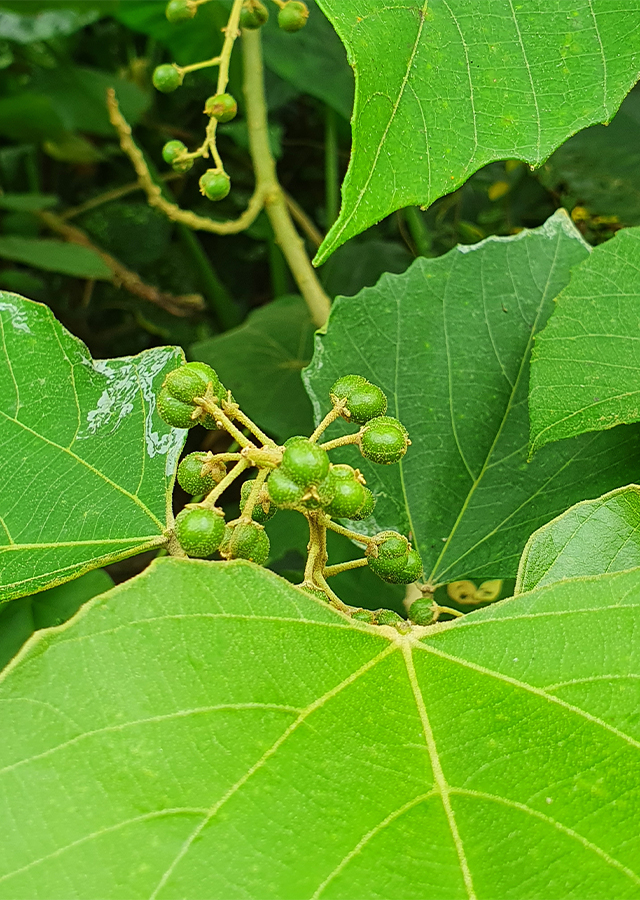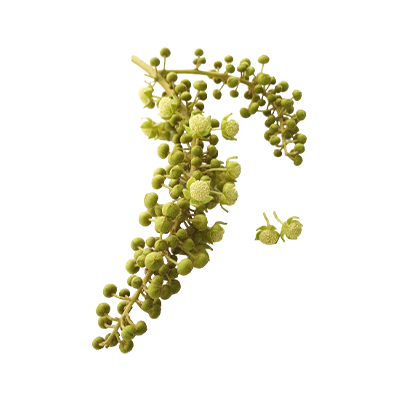Alim
Melanolepis multiglandulosa (Reinw. ex Blume) Rchb. & Zoll.
Euphorbiaceae
Location in our garden
Principal



Synonym
Melanolepis angulata Miq.
Melanolepis calcosa Miq.
Melanolepis moluccana Pax & K.Hoffm.
Habitus
Trees. An evergreen perennial shrub or tree, a medium-size tree grows 4-10 m tall, though it can reach up to 20 m.
Part Used
Leaves
Bark
Flowers
Growing Requirements
Full Sunshine
Need Shade
Habitat
Wetland
Forest
Roadside
Shrublands
Overview
Alim is native to South-East Asia, Nansei-shoto, Mariana Islands, Solomon Islands, Bismarck Archipelago, New Guinea. This species should be a good choice within its native range as a pioneer species when restoring native woodland and also for establishing woodland gardens. The plant is harvested from the wild for local use as a medicine, a sweetener and source of materials.
Vernacular Names
Alim (Tagalog-Philippines), Avima (Papua New Guinea), C[as]nh di[eef]u (Vietnamese), Mo lin (Chinese), Chawan (Malaysia), Petewei (Urimo), Bapap (Bel language), Daun Kapur (Indonesia)
Agroecology
Growing mainly secondary places like roadsides, regrowth thickets, depleted open forest, forest edges in savannah, coconut plantations, old gardens, also primary forest, swamp forest, monsoon forest, by mangroves; from 300 to 1,335 m elevation. Often found in the wild on poorly drained and/or temporary inundated: alluvial sand, clay, vulcanic soil, coral (sand), red loam; Andesite bedrock.
Morphology
- Bark - up to 30 cm in diameter, exceptionally to 60 cm.
- Leaves - spirally arranged, simple, orbicular-ovate, and often deeply 3 - 4-lobed, 10 to 25 cm long, very broad, base cordate to cuneate, apex acute to acuminate, venation palmate with 5(-7) major veins, margin dentate.
- Flowers - actinomorphic, sepals (4-)5, valvate, petal absent, sepals ovate, greenish yellow.
- Fruits - a lobed capsule, obcordate in outline, smooth and consisting of 2 or 3 parts. The pendant fruits are pea-sized, green at first, becoming brown.
- Seeds - 5.5-6 mm x 4.5-5.5 mm, creamy to purplish magenta.
Cultivation
Generative propagation is by seeds. It shows canopy-induced facultative dormancy, but it germinates readily under sunny conditions, completing germination within 5 weeks.
Chemical Constituents
Friedelin, oleanolic acid, β-amyrin asetat, phytosterol, stigmasterol, β-sitosterol, squalene, β-carotene, alkaloids, flavonoids, saponins, tannins.
Traditional Medicinal Uses
- The plant is sudorific and vermifuge.
- Studies have suggested antiviral and antioxidant properties.
- The bark is taken as a tea in the treatment of cough.
- The bark, leaves, and flowers, either fresh or slightly heated, are applied to the skin as a sudorific in the treatment of chest pain and fever.
- In Peninsula Malaysia and Sumatra, decoction of the leaves, often in a mixture with other plants, is used as a vermifuge. The leaves also sometimes mixed with ginger, used as a poultice against different kinds of scurf.
- In Sulawesi-Indonesia, a tea of the leaves is also used as a treatment for cough.
- In Papua New Guinea, infusion of crushed dried leaves, mixed with cold water, are drunk to treat constipation, chest complaints and tuberculosis. To treat snake bites, the bark is cut and the inner part squeezed or chewed and the milky sap is swallowed
- In Taiwan, roots are used as anti-infection, diuretic, and insecticide.
Part Used
Reference Sources
- Apostol, P.G., Reyes, M.M., Altena, I.A., and Ragasa, C.Y. (2016). Chemical Constituents of Melanolepis multiglandulosa (Reinw. Ex Blume). International Journal of Pharmaceutical and Clinical Research Vol.8(12), (pp.1663-1665). https://www.researchgate.net/publication/312147483_Chemical_Constituents_of_Melanolepis_multiglandulosa_Reinw_ex_Blume (accessed 22-02-2021).
- Fern, Ken. (2014). Useful Tropical Plants: Melanolepis multiglandulosa. http://tropical.theferns.info/viewtropical.php?id=Melanolepis+multiglandulosa (accessed 15-10-21).
- StuartXchange. (2016). Philippine Medicinal Plants: Alim Melanolepis multiglandulosa (Reinw. ex Blume) Reichb. & Zoll. http://www.stuartxchange.org/Alim.html (accessed 22-02-2021).
- Kew Science. (No date). Plants of The World Online: Melanolepis multiglandulosa (Reinw. ex Blume) Rchb. & Zoll. http://www.plantsoftheworldonline.org/taxon/urn:lsid:ipni.org:names:352136-1 (accessed 22-02-2021).
- University of Guam. (2015). Melanolepis multiglandulosa. https://cnas-re.uog.edu/guam-plant/melanolepis-multiglandulosa/ (accessed 22-02-2021).
- Mebs, D. (2000). Notes on the traditional use of plants to treat snake bite in northern Papua New Guinea. Toxicon, 38(2), 299–302. doi:10.1016/s0041-0101(99)00148-8 (accessed 15-10-21).
- Van Welzen, P.C. (2002). Melanolepis multiglandulosa (Reinw.ex Blume) Rchb.f. & Zoll. In: van Valkenburg, J.L.C.H. and Bunyapraphatsara, N. (Editors): Plant Resources of South-East Asia No 12(2). Medicinal and poisonous plants 2. Prosea Foundation, Bogor, Indonesia. pp 361 - 363.



